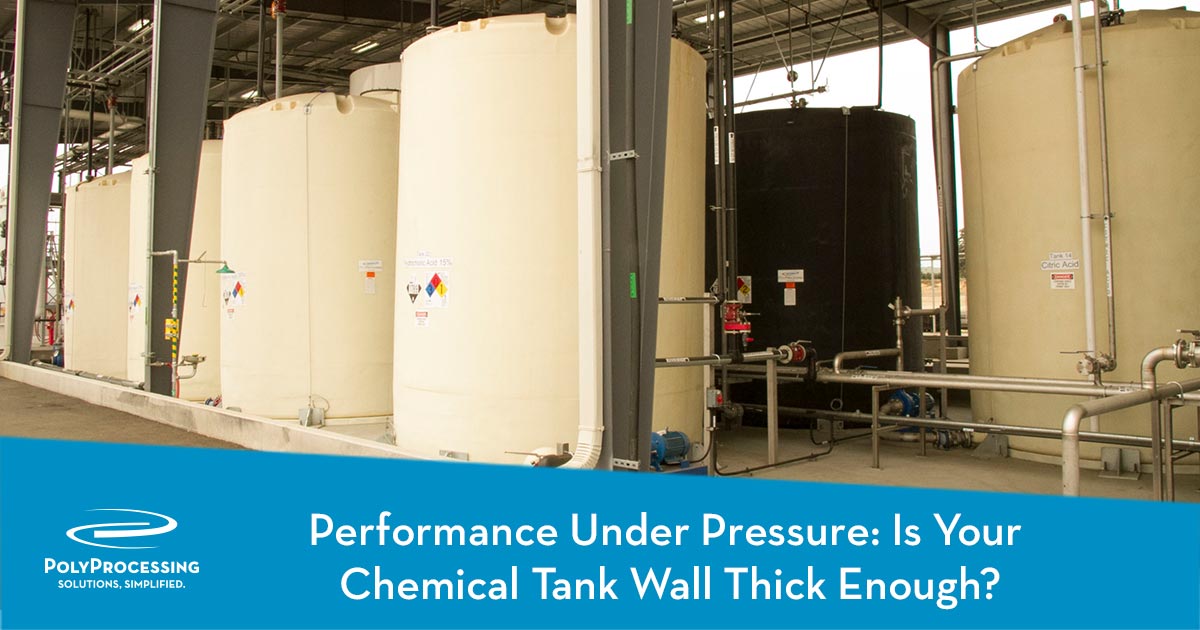Performance Under Pressure: Is Your Chemical Tank Wall Thick Enough?
If you want your polyethylene chemical storage tank to last for its full lifetime, you’ll need to make sure your tank has the right specific gravity rating. Every chemical has its own specific gravity, and it’s critically important that your tank is designed to meet the demands of the particular chemical you’re storing. Tanks that are rated too low can suffer from mechanical stress and early failure.
What Is Specific Gravity and Why Is It Important?
Specific gravity is the ratio of the density of a chemical to the density of a standard, usually water. If you’re storing a chemical with the same density as water, the specific gravity is 1.0. If it has twice the density of water, the specific gravity is 2.0.
In relation to your chemical storage tank, specific gravity is a number that indicates the proper wall thickness. A chemical’s specific gravity (SPG) of 1.9 requires specific inches of wall thickness, according to ASTM standards. At Poly Processing, a tank’s SPG is calculated for you to match what you need for the chemical you’re storing. A 1.9 tank for example, meets ASTM guidelines of a necessary wall thickness to hold a chemical with a specific gravity of 1.9 or less.
Both weight and temperature of the chemical dictate your tank’s specific gravity rating. Let’s take a look at how Poly Processing accounts for temperature and weight to determine the wall thickness you’ll need in your particular chemical storage application.
Accounting for Chemical Storage Temperature
The specific gravity rating is especially important when you take into account the temperature at which you will be storing your chemical. There’s a common misconception that the temperature refers to the ambient temperature of the environment. Instead, the temperature refers to the actual temperature of the chemical being stored.
For many manufacturing projects, the chemical may need to be kept at a slightly elevated temperature, instead of room temperature. If this is a concern for your application, then it’s important to consider how your chemical’s temperature could affect your tank’s design thickness.
How Tank Temperature Dictates Tank Wall Thickness
The thickness of a Poly Processing storage tank’s wall is calculated for every tank, to ensure that the storage system is safeguarded from the chemical. With some chemicals, such as sulfuric acid, the heavy weight of the chemical can cause damage to the storage tank’s wall if the tank is not made for the specific chemical. Simply put, a heavier chemical, especially at temperatures above 100 deg F, requires a thicker tank wall in comparison to simply storing something such as ambient temperature water.
Poly Processing offers five different tank wall thicknesses, depending on your chemical's specific gravity:
- 1.0 spg
- 1.35 spg
- 1.65 spg
- 1.9 spg
- 2.2 spg
As your fluid specific gravity increases, a storage system will require a thicker wall to withstand additional stress from the increased temperature and weight. The maximum service temperature for our XLPE tanks is 150 deg F, assuming your chemical’s fluid specific gravity is 1.00.
You can find out more information about your specific chemical’s fluid specific gravity by checking out our list of commonly stored chemicals.
Best Practices Concerning Specific Gravity Rating
Need help understanding your chemical storage system’s tank requirements? Follow these steps to ensure that you have built a tank system capable of storing your specific chemical:
- Determine the exact chemical name of the substance that you want to store. At Poly Processing, we rely on the chemical’s material safety data sheet (MSDS) to build a tank that matches your specific needs.
- Have an idea of whether or not the temperature of the substance that you are storing will be ambient and what its variance will be. For substances with a relatively high level of temperature variance, allow additional tolerance to ensure that the quality of the substance is not compromised.
- Submit all relevant chemical and storage condition data to one of our tank specialists so that we can verify that you’ve selected the right tank based on your requirements.
How Does the OR-1000 System Affect Wall Thickness?
We use the OR-1000™ System for heavy oxidizers, which adds a protective barrier to the tank wall. However, that added protection isn’t included in the wall thickness calculation. So when we build the tank, we make the tank wall as thick as it needs to be, then add the OR-1000 as a barrier system for the heavy oxidizers. Usually it’s a nominal 3/16”.
Rely on Our Expertise
For over four decades we’ve been helping customers develop storage solutions for corrosive chemicals. Let us lend our expertise and knowledge to help you pick the right tank so that you have total peace of mind about your chemical storage.
Contact a chemical storage expert to determine the specific gravity rating required for your chemical storage application.
- June 6, 2019
- Topics: Value Added
About Poly Processing
Posts By Topic
Tech Talk Podcast Episodes
Subscribe By Email
Recent Posts
- Installation Tips for Chemical Storage Tanks: Site Preparation and Offloading
- Understanding pH and Chemical Concentration When Choosing a Chemical Tank
- Maximizing Fill Efficiency: Selecting the Optimal Fill Line System
- Chemical Storage Tanks: A Quick Guide for End Users
- Popular Customization Options for Chemical Storage Tanks
Tank Configurator

Find the recommended tank and system components for your chemical storage challenge.
Configure a Tank Package



